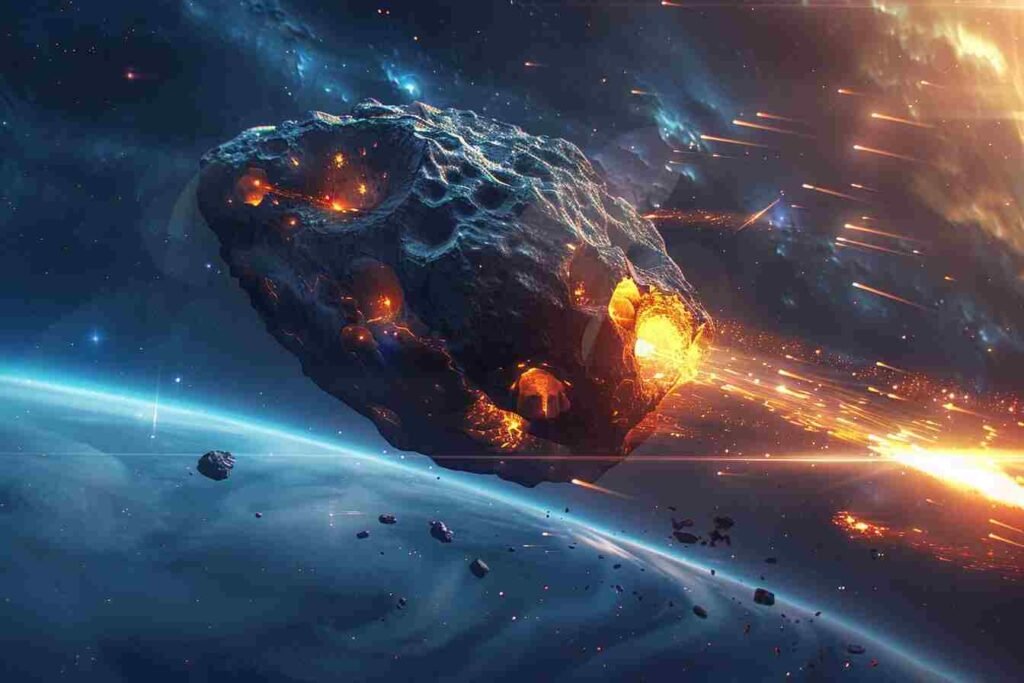Decoding the Journey of Earth’s Nearby Asteroid Apophis
The asteroid Apophis, nicknamed the “God of Chaos”, the subject of numerous studies since its discovery in 2004, represents a case of particular interest due to its dangerous future proximity to our planet in 2029. Thanks to precise observations and advanced simulations, scientists were able to refine their predictions… Spoiler alert: we fear nothing!
Monitoring near-Earth asteroids constitutes a crucial part of modern astronomy, aimed at preventing risks to our planet. Among them, the asteroid Apophis, also known as asteroid 99942, stands out for its imposing size and its trajectory which will bring it remarkably close to Earth in 2029. Discovered in 2004, Apophis initially raised concerns regarding a possible collision. Moreover, it owes its name to the demon serpent, which personified evil and chaos in ancient Egyptian mythology. However, recent studies, conducted by the University of Western Ontario and the University of Waterloo, have ruled out this hypothesis. This work, available on the arXiv pre-print platform, concludes that there is no risk of collision with other asteroids which could modify its trajectory towards Earth.
The reassuring trajectory of Apophis
Near-Earth Object (NEO), estimated at around 335 meters in diameter, Apophis is infamous for its next close passes of the Earth, expected in 2029 and 2036. Indeed, on April 13, 2029 (yes, it will be a Friday!), it will brush past us at just 37,399 kilometers. Certainly, this gap remains tiny on a cosmic scale, if it does not change trajectory between now and then.
This approach, well below the orbit of many geostationary satellites, represents an unprecedented opportunity for the scientific community. The latter will be able to observe an asteroid of this size without resorting to a specific space mission. Direct observation will provide information on the composition, structure and dynamics of such a celestial body.
Despite initial concerns, extensive studies have dispelled any doubts about a potential collision with our planet. Trajectory calculations, refined through years of observations and analyses, have confirmed that Apophis poses no danger to Earth for the coming century.
The 2029 Close Approach: A Scientific Opportunity
On April 13, 2029, Apophis will pass within approximately 31,000 kilometers (19,000 miles) of Earth’s surface. This event presents a rare opportunity for scientists to study an asteroid up close. Telescopes around the world will be trained on Apophis, providing valuable data on its size, shape, composition, and possibly even its internal structure.
To put that in perspective, this distance is closer than some of our geosynchronous satellites, which orbit at about 35,786 kilometers (22,236 miles) above the Earth’s equator. This makes the 2029 encounter with Apophis a significant event for both astronomers and the public.
Understanding Apophis’ Composition and Origin
Apophis is categorized as a Type LL chondrite asteroid, which provides clues about the early solar system. These asteroids are believed to be remnants of the primordial material that formed the planets. Studying Apophis could offer insights into the formation and evolution of our solar system.
The Role of Technology in Asteroid Monitoring
The story of Apophis highlights the importance of technological advancements in space observation and asteroid tracking. Programs like NASA’s Planetary Defense Coordination Office and the European Space Agency’s Space Situational Awareness program play crucial roles in identifying and monitoring near-Earth objects (NEOs).
Looking Beyond 2029: Future Encounters and Preparedness
While the 2029 encounter with Apophis is a primary focus, scientists are also looking ahead to its next close approach in 2036. The continuous monitoring and study of Apophis and other NEOs are vital in preparing for any potential future threats.
Conclusion: Embracing a Universe of Possibilities
Asteroid Apophis, once a harbinger of potential doom, has transformed into a symbol of scientific curiosity and human ingenuity. As we anticipate its 2029 flyby, Apophis continues to remind us of the vastness of space and our quest to understand the mysteries it holds.
This article aims to inform and engage readers with the intriguing story of Apophis, emphasizing its scientific significance and the ongoing efforts in space research and planetary defense.
Sources: Western University, PinterPandai
Photo powered by Midjourney
Nasa DART Mission | First time crashed into an asteroid to change its trajectory

